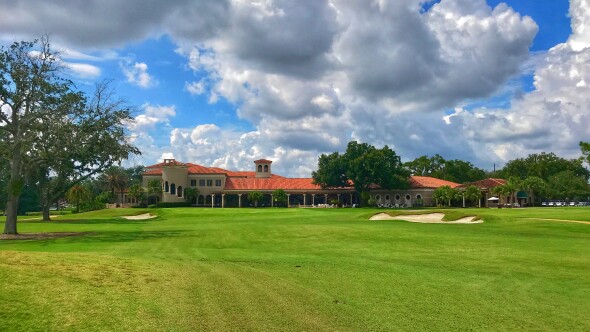Kristen Gillman wants her quiet afternoons at her club back.
"I always joke with my dad," the LPGA Tour pro said prior to the U.S. Women's Open at Champions Golf Club, "that people need to go back to their own workplace so I can start doing my job, too! And have more of the course to myself."
Whether you’re playing on a muni or at the best club in town, the COVID-19-induced phenomenon of “work from anywhere” led to stacked tee sheets and crowded driving ranges. The National Golf Foundation reports that rounds played in the U.S. are up by 50 million year-over-year — a remarkable statistic that factors in spring shutdowns that canceled up to 20 million rounds.
In fact, 2020 is the best year for golf rounds since 1997, when Tiger Woods first broke through at the Masters.
This newfound enthusiasm for golf is shaking up the private club business after a decade of oversupply, maturing memberships and club closures. Earlier this year, analysts debated the long-term viability of the country club lifestyle, which first emerged in the 1920s and expanded along with the suburbs from the 1950s through the 1990s. Experts worried about the industry’s reliance on aging baby boomers and its struggle to attract millennials.
The takeover of publicly-traded ClubCorp by a private equity firm was a signal for many people that the country club business model was broken, at least by Wall Street standards. It looked like the growth in golf would come from hip, non-traditional concepts like Topgolf, which planned a 2020 IPO.
That narrative has gone dormant.

The new coronavirus pandemic is accelerating certain lifestyle trends and creating new ones. Millennials who have typically preferred the big-city lifestyle have decided the ‘burbs aren’t so bad. The magnetic pull of expensive cities like New York and San Francisco is weakening.
Even prior to the pandemic, an analysis of club business data and recent surveys by NextGenGolf at the PGA Merchandise Show this past January showed a growing desire among millennials to seek the benefits of the club lifestyle for their families. But they weren’t being marketed to properly.
Then COVID-19 arrived. Beginning in mid-March, one-third of America’s states began closing golf facilities. Some member-owned clubs challenged the legality of the shutdown and defied state orders. Other clubs were allowed to continue operating as long as they made significant changes to protect the safety of their staff and members.
During that surreal stretch from mid-March thru April, expectations changed quickly for large club operators.
"At first it was safety, then to retain members the best we could," said Rob DeMore, President of Troon Privé, which operates over 100 private clubs around the world. "And then it turned out there's likely an incredible opportunity coming."
Roughly half of all American golf courses were closed in April. Many were in the Midwest and Northeast, markets where sun-starved golfers were eager to break out the clubs after the snow melted.
New Jersey had one of the most prolonged and restrictive spring lockdowns. State officials ordered golf courses closed from March 31 through May 2. For a period of time after, courses were restricted to twosomes only and 16-minute tee time intervals. It was practically impossible to get a tee time anywhere.
In West Orange, New Jersey, club officials opened Montclair Golf Club as soon as the state granted permission. They immediately experienced a surge of interest in memberships, especially from young professionals escaping New York City. “The inquiries started flying in,” said Reagan Finnesey, membership director at Montclair. “They’re still flying in. I have tours scheduled through December. This never happens.”
Montclair added 81 members in 2020 (vs. 20 in 2019); 59 of those are young professional memberships and families. An ongoing capital improvement project, which includes renovations to Montclair's 36-hole golf course and the addition of a new pool and racket sports complex, “can’t be completed soon enough” Finnesey said.
"[For] folks who had been contemplating membership, this was their push to get going."

Junior executive memberships and young families are driving this new growth, a statistic that bodes well for the industry’s future. The average age of new members declined from 58.6 in 2017 to 54.9 in 2020, according to a recent market report from Golf Life Navigators, a service that matches golfers with club memberships that best suit their lifestyles.
“Our belief is that these individuals watched their parents work well into their 70s and don’t wish to wait that long before investing in their own health and lifestyle,” said Jason Becker, Golf Life Navigators CEO.
GGA Partners, an international consulting firm and adviser to private clubs, conducted an extensive survey of over 6,300 members worldwide July to find what's driving the surge in both golf and the club space.
"What we've learned is the importance and relevance of clubs is strengthened during emotionally challenged times," said Michael Gregory, a partner at GGA. "What people are lacking in their lives, some clubs have found a way to really bridge that gap and provide an outlet."

If you’re looking for the epitome of a safe and socially-distanced enclave, it might be Santa Lucia Preserve in Carmel, California. A long, winding entrance road takes you inland over mountains and into a lush, 20,000-acre expanse with fewer than 300 homesites. In addition to golf, the community offers hiking trails, fishing and horseback riding.
It sounds like a place to go to get totally off the grid. But in fact, the development has gigabit internet service, making it a work-from-home paradise for Silicon Valley tech executives. Donal Daly, membership sales manager, told me their golf club has signed up 68 full golf members in 2020, compared to 11 in 2019.
"We have better broadband than parts of Silicon Valley," said Daly.

A decade of widespread capital improvements pays off
Back in March, during the surreal week of The Players Championship and the overall sports shutdowns, I traveled to the Big Island of Hawaii and the Four Seasons Hualaiai Resort & Club. They were showing off their new “Golf Hale” concept, a 3,000-square foot indoor/outdoor entertainment pavilion — similar to Topgolf, but more exclusive. Golf Hale features three Trackman-enabled simulators for fitting and instruction, plus a variety of non-golf games like hockey and zombie hunting.
Clubs all across the country have been on a torrid investment pace in recent years. The Club Management Association of America estimates clubs spent $3.2 billion on capital investments in 2018 and another $3 billion in 2019. Montclair is rounding the corner on its ambitious $18 million investment. At Troon, DeMore estimates three-quarters of their Privé portfolio recently underwent some form of multi-million-dollar investment. Interest in these clubs skyrocketed when consumers stopped looking for trips abroad and started looking for escapes in their own backyard.
Marc Schulz, 38, had a City of Austin muni pass until the second COVID-19 shutdown in August. Frustrated, he shopped around for a club membership and found initiation fees had gone up significantly at most of the clubs he called a few years ago. He ultimately committed to the University of Texas Golf Club, because it had a short course, the Spieth Lower 40, which was added in 2017.
“The short course was a big factor for me. It’s a lot easier to go around the short course a couple of times after work,” the tech professional told me.
Clubs that could raise capital have been revamping their facilities to cater to a new generation of members. Bluejack National, located about an hour north of Houston's urban core, grew memberships 160% year-over-year and rounds are up 91%. It's a high-end club with a Tiger Woods-designed course but has a casual vibe, highlighted by a lighted par-3 course. Across the U.S., casual concepts are replacing fine dining rooms. Fitness centers are being reimagined for Pilates, weights and group fitness classes. Pickleball for all ! New programming and amenities for kids are proving that the 21st century golf club isn’t just for Dad.

Private club outlook 2021: More new members, fewer weddings, better tee-sheet management
Northern Michigan is a market that exemplifies the boom-bust cycle the industry experienced beginning in the late 1990s. Yet in December, with snow still on the ground all over the Mitten, a public property that opened during an earlier boom, Lochenheath Golf Club near Traverse City, announced it was finally going private in 2021. The realization of their original model was twenty years in the making.

The era of the semi-private golf club, one that offers limited public access or Groupon-style social deals, has likely hit its peak. GolfNow's Marketplace Lead Program has driven 1,197 leads this year to participating private clubs. However, some pandemic-induced changes probably won’t go away. Scheduling flexibility for creative-class workers will remain in some form. So long as young families find the time, they will likely continue to sign up for full golf memberships.
Member satisfaction surveys are currently high at clubs due to grateful members (at Golf Advisor, our community's average course star rating is up over 10% vs. 2019). But at some point, members may grow tired of jostling for tee times. Escondido Golf & Lake Club in Texas reports member tee times are up 59% year-over-year. The private club dilemma of filling memberships has, in the course of a year, shifted to a question of finding open tee times for members.
"We had clients go through peak season and on the weekend they'd consistently have member ballots and 50-100 members couldn't get a tee time." said Gregory. "The flexibility the pandemic has provided will continue for a lot of people."
Another major hurdle facing clubs in 2021 is how to handle weddings and outside business groups. In 2020, with those events throttled down, members have grown comfortable not having to share facilities with outside groups. Clubs with healthy books can afford to be picky with outside business. But clubs more dependent on outside revenue may need to transfer some of those costs to members.
"I think you will see clubs reset their dues to become far more self-sufficient" said Demore. "I know a number of us have been saying that's needed."
The new normal
At some point next year, restaurants and movie theaters will reopen to capacity. Air travel will take off again. Youth sports will resume. Other activities will once again compete with golf. Will all those people who found safe haven in the sport in 2020 be willing to give it up in 2021?
When the pandemic shut down the LPGA Tour this spring, it upended Stacy Lewis’ travel and competition schedule. She became just another avid golfer trying to get a tee time at Champions Golf Club in Houston, where so many golfers took advantage of their new flex-time to find a little peace on the links.
"I've realized the value in slowing down a bit," said Lewis. "And taking time for yourself and having some balance with your work life and that's what you're seeing with the boom in golf."


















Played more this year had trouble getting tee time about 10%